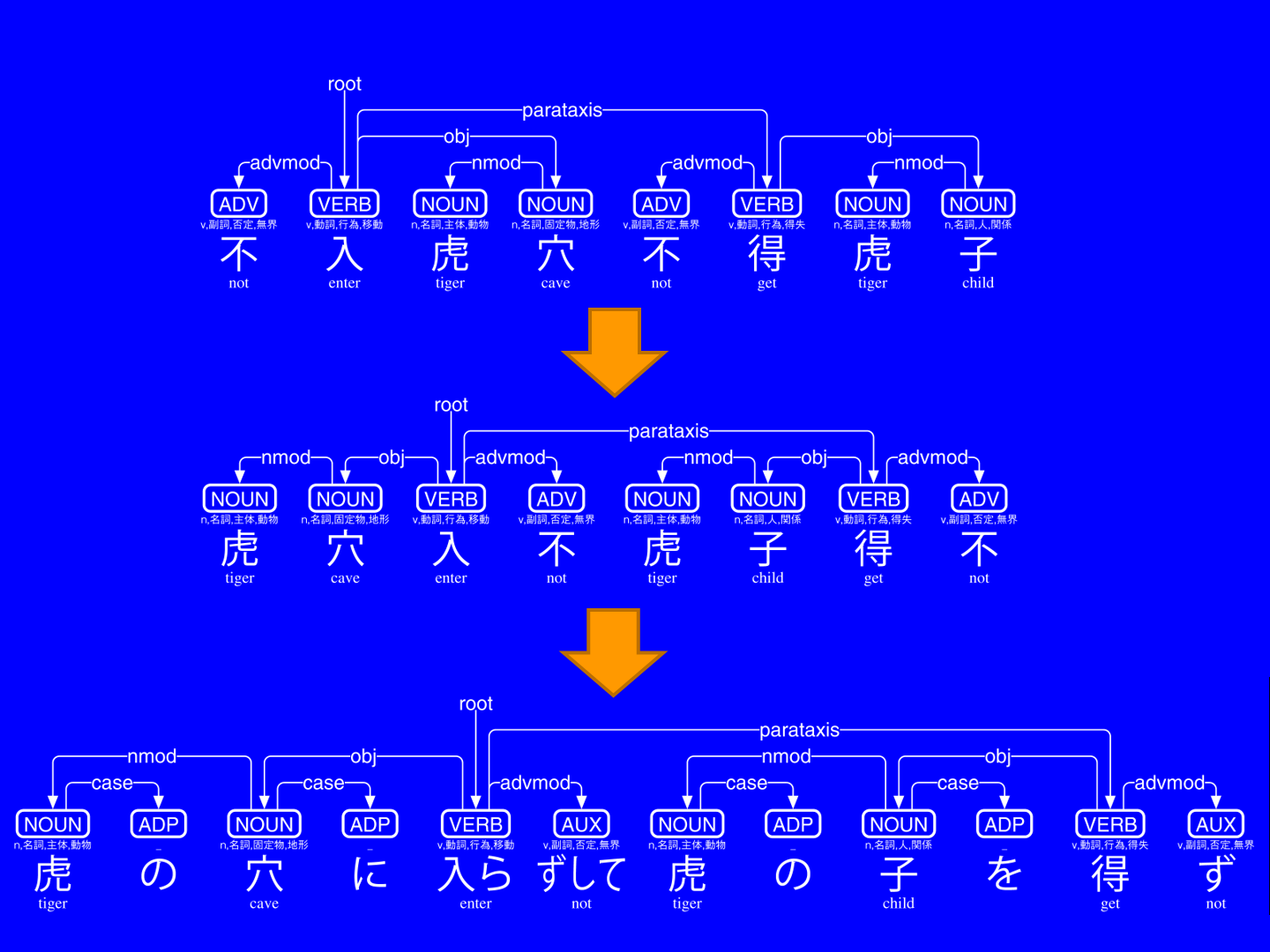Classical Chinese to Modern Japanese Translator
Project description
UD-Kundoku
Classical Chinese to Modern Japanese Translator, working on Universal Dependencies.
Basic usage
>>> import udkundoku
>>> lzh=udkundoku.load()
>>> s=lzh("不入虎穴不得虎子")
>>> t=udkundoku.translate(s)
>>> print(t)
# text = 虎の穴に入らずして虎の子を得ず
1 虎 虎 NOUN n,名詞,主体,動物 _ 3 nmod _ Gloss=tiger|SpaceAfter=No
2 の _ ADP _ _ 1 case _ SpaceAfter=No
3 穴 穴 NOUN n,名詞,固定物,地形 Case=Loc 5 obj _ Gloss=cave|SpaceAfter=No
4 に _ ADP _ _ 3 case _ SpaceAfter=No
5 入ら 入 VERB v,動詞,行為,移動 _ 11 advcl _ Gloss=enter|SpaceAfter=No
6 ずして 不 AUX v,副詞,否定,無界 Polarity=Neg 5 advmod _ Gloss=not|SpaceAfter=No
7 虎 虎 NOUN n,名詞,主体,動物 _ 9 nmod _ Gloss=tiger|SpaceAfter=No
8 の _ ADP _ _ 7 case _ SpaceAfter=No
9 子 子 NOUN n,名詞,人,関係 _ 11 obj _ Gloss=child|SpaceAfter=No
10 を _ ADP _ _ 9 case _ SpaceAfter=No
11 得 得 VERB v,動詞,行為,得失 _ 0 root _ Gloss=get|SpaceAfter=No
12 ず 不 AUX v,副詞,否定,無界 Polarity=Neg 11 advmod _ Gloss=not|SpaceAfter=No
>>> print(t.sentence())
虎の穴に入らずして虎の子を得ず
>>> print(s.to_tree())
不 <┐ advmod
入 ─┴─┐<┐ advcl
虎 <┐ │ │ nmod
穴 ─┘<┘ │ obj
不 <┐ │ advmod
得 ─┴─┬─┘ root
虎 <┐ │ nmod
子 ─┘<┘ obj
>>> print(t.to_tree())
虎 ─┐<┐ nmod(体言による連体修飾語)
の <┘ │ case(格表示)
穴 ─┬─┘<┐ obj(目的語)
に <┘ │ case(格表示)
入 ─┬───┘<┐ advcl(連用修飾節)
ら │ │
ず <┘ │ advmod(連用修飾語)
し │
て │
虎 ─┐<┐ │ nmod(体言による連体修飾語)
の <┘ │ │ case(格表示)
子 ─┬─┘<┐ │ obj(目的語)
を <┘ │ │ case(格表示)
得 ─┬───┴─┘ root(親)
ず <┘ advmod(連用修飾語)
udkundoku.load() is an alias for udkanbun.load() of UD-Kanbun. udkundoku.translate() is a transcriptive converter from Classical Chinese (under Universal Dependencies of UD-Kanbun) into Modern Japanese (under Universal Dependencies of UniDic2UD). udkundoku.reorder() is called to rearrange Classical Chinese into Japanese word-order inside udkundoku.translate(). to_tree() and to_svg() are borrowed from those of UD-Kanbun.
You can simply use udkundoku on the command line:
echo 不入虎穴不得虎子 | udkundoku -j
HTTP-server usage
python -m udkundoku.server 5000
Try to connect http://127.0.0.1:5000 with your local browser. Input a Classical Chinese sentence there and push 解析-button (at least) three times.
Installation for Linux
Tar-ball is available for Linux, and is installed by default when you use pip:
pip install udkundoku
旧仮名口語UniDic is automatically downloaded for UniDic2UD.
Installation for Cygwin
Make sure to get gcc-g++ python37-pip python37-devel packages, and then:
pip3.7 install udkundoku
Use python3.7 command in Cygwin instead of python.
Installation for Jupyter Notebook (Google Colaboratory)
!pip install udkundoku
Author
Koichi Yasuoka (安岡孝一)
References
- 安岡孝一: 漢文自動訓読ツールUD-Kundokuの開発, 東洋学へのコンピュータ利用, 第32回研究セミナー (2020年3月6日), pp.3-25.
Project details
Release history Release notifications | RSS feed
Download files
Download the file for your platform. If you're not sure which to choose, learn more about installing packages.













